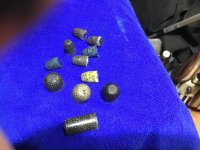What do you think about bullets made of copper powder held together by epoxy resin?
Some companies have been selling them for a while now. I think they are also easy to make at home, you don't even need a stove. You can also use a plastic mold because you don't need other temperatures.
One benefit could be that they destroy on impact and release all the energy on the surface. High velocity and energy transfer are the basis for a good defensive bullet. What do you think?
Some companies have been selling them for a while now. I think they are also easy to make at home, you don't even need a stove. You can also use a plastic mold because you don't need other temperatures.
One benefit could be that they destroy on impact and release all the energy on the surface. High velocity and energy transfer are the basis for a good defensive bullet. What do you think?

